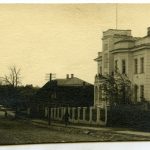The Importance of the City for the Newly Created State
After the First World War, it did not take long for Šiauliai to stand on its feet, and the city’s inhabitants were among the most active creators of the foundations for the internal life and politics of the new state. Šiauliai self-governance was firm, rallying politicians who well knew their aim and had the vision, such as lawyer Kazimieras Venclauskis who had already acquired considerable experience in self-governance still in the years of occupation and who became the first burgomaster of the city and formed the guidelines for self-governance policy; cultural and social activist Antanas Mikševičius, who chaired the management board of Šiauliai cultural society ‘Varpas’ before the war; economist Jackus Sondeckis, who always remaining loyal to social democratic values, greatly improved the city’s health and social situation and laid down the city’s further development guidelines.
The geographical position of Šiauliai again became the reason for its prosperity. In 1923, when the Republic of Lithuania incorporated Klaipėda area, at last it had a port that could be used for trade; thus, the state had to immediately connect Klaipėda and its port with the rest of Lithuania, and Šiauliai as a connecting point became strategically very important. The railway lines were soon built from Šiauliai to Telšiai, and later, via the later, to Kretinga and Klaipėda. Šiauliai tradesmen turned towards Klaipėda through which the relationships with foreign traders were established and there was no need to use the services of Riga port as before.
The improving economic situation boosted the rapid growth of the city. Soon, nearby former settlements were connected, such as the territories of Ginkūnai, Aleksandrija and Gubernija manors, previously ruled by counts the Zubovai, increasing the area of the city more than twice. The residents, who were hiding abroad and in the depth of Russia from the horrors of war, returned. The national composition of the townsmen changed considerably. Still in 1909, the population census data showed that more than half of the townsmen were Jews, while the Russian community was only slightly smaller than that of Lithuanians, but the population census of 1923 showed that the Jewish community declined by half, while Russian representatives almost disappeared. At that time, Lithuanians made up two thirds of the city’s population.
Before the war, Šiauliai was famous for a large group of intellectuals who actively fostered cultural, educational and public activities. Even Kaunas, which at that time did not rally such a large group of enlightened persons, could envy the number and personalities of Šiauliai intellectuals. Unfortunately, Šiauliai did not manage to retain these people during the interwar period. They were tempted to move to the temporary capital to form the core of the professors of the newly established University of Lithuania (the future Vytautas Magnus University) and contribute to the creation of the administrative apparatus of the state. These were such prominent public figures and educators as Jonas Šliūpas, Mykolas and Vaclovas Biržiškos, Kazys and Stasys Šalkauskai, Kipras Bielinis, Rapolas Skipitis, and Vladas Požela. Even after such intellectuals’ loss, Šiauliai managed to preserve part of the intelligentsia, which, led by burgomaster J. Sondeckis and lawyer K. Vencliauskis, even having lost its former associates (most of them, like the ones who left, were social democrats and left-wing representatives), significantly contributed to the restoration of the city, which achieved its prosperity in fourth decade of the 20th century, under the rule of strong burgomasters J. Sondeckis and Juozas Valančius. Under the rule of the latter, in 1931-1938, nice modernist buildings arose, the infrastructure of the city – sanitation, telecommunications and electricity networks – was developed.








Leave feedback